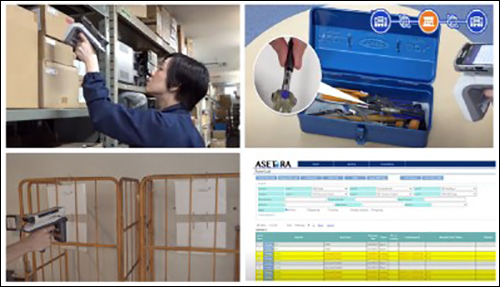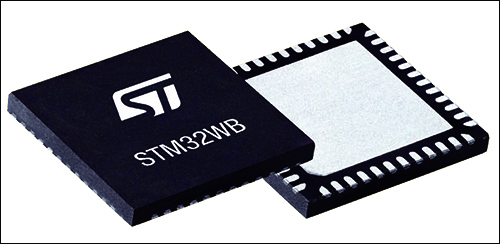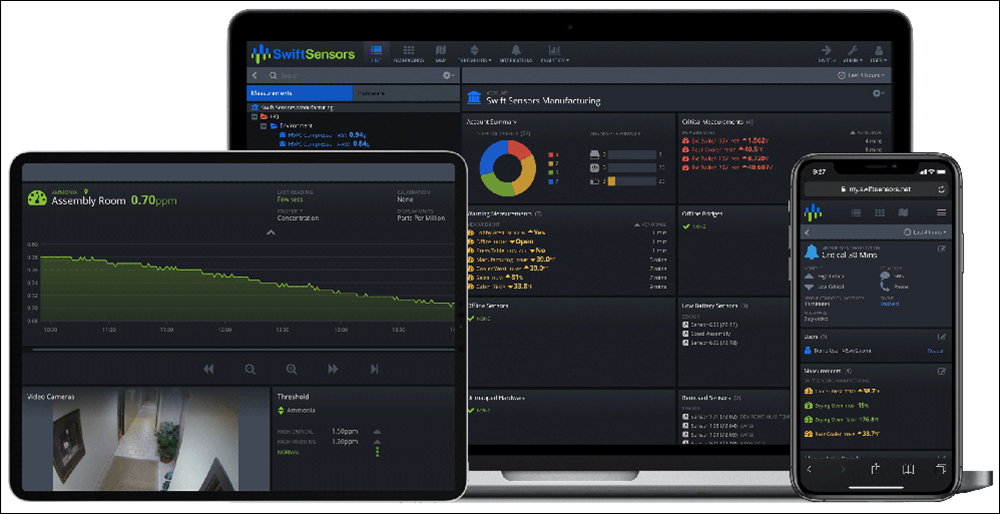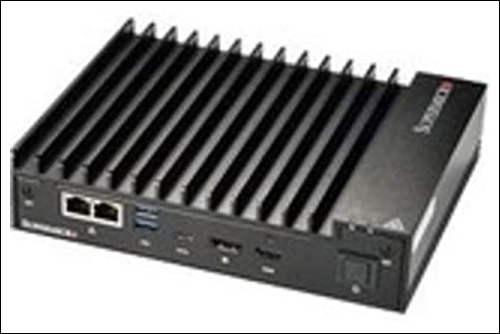Presented here are recent news announcements regarding the following organizations: NXP Semiconductors, SATO, STMicroelectronics, Swift Sensors, Litmus, Super Micro Computer, OptConnect and Canvass Analytics.
NXP Intros UWB ICs for IoT Use Cases
NXP Semiconductors has expanded its ultra-wideband (UWB) technology portfolio to include new UWB IC models known as the Trimension SR040 and SR150. The ICs are designed to enable new Internet of Things (IoT) use cases, such as smart locks and real-time location system (RTLS) tags. The Trimension tags are built specifically for the automotive, mobile and IoT markets.
“At NXP, we’re convinced that true innovation happens at the intersection of ecosystems. To accelerate the adoption of UWB and create meaningful new experiences, smart edge devices need to gain spatial awareness, whether it’s a smartphone, car or different IoT device form factor,” said Rafael Sotomayor, NXP’s EVP of BL connectivity and security, in a prepared statement. “Imagine the possibilities of moving through daily life with fewer barriers as devices anticipate our actions. Our new IoT ICs, combined with NXP’s connectivity portfolio, will help developers add dimensionality to devices and objects to make this vision possible.”
 According to NXP, UWB technology is enabling a world in which doors lock and unlock in response to an owner’s presence, cars are shared with a simple touch of a screen or accessed handsfree, and smart-home automation systems follow their owners intuitively and efficiently from one room to another. In addition, the company explains, people now spend less time searching because misplaced items can be tracked instantly.
According to NXP, UWB technology is enabling a world in which doors lock and unlock in response to an owner’s presence, cars are shared with a simple touch of a screen or accessed handsfree, and smart-home automation systems follow their owners intuitively and efficiently from one room to another. In addition, the company explains, people now spend less time searching because misplaced items can be tracked instantly.
“With higher levels of accuracy in positioning capabilities, along with increased data security compared to other RF technologies, UWB will significantly improve the handsfree access-control user experience in places such as offices, hospitals, educational institutions and homes,” added Ramesh Songukrishnasamy, HID Global‘s senior VP and CTO, in the prepared statement. “Based on its fine-ranging capability, we also believe UWB will enable many new location-based services and device-to-device IoT applications, both in consumer products and industrial applications.”
Designed for IoT devices, the Trimension SR150 utilizes angle-of-arrival technology. According to the company, the Trimension SR150 is suitable for the UWB enablement of larger infrastructures, such as access-control installations, indoor localization setups and payment schemes, as well as consumer electronics. Several SR150 IC devices can be placed in a room as UWB anchors to help localize people and objects as they move. Intended for low-power operation, the Trimension SR040 can be used in battery-operated IoT devices, including UWB trackers and tags, and can be integrated with Bluetooth Low Energy (BLE) or other connectivity controllers on a single device.
SATO Unveils RFID Asset-Management System for Manufacturing, Logistics
SATO, a provider of auto-ID and labelling solutions, has launched its ASETRA system, which employs RFID tags, QR codes and barcodes to simplify the management of tools and returnable transport items (RTIs). The solution is designed for use by manufacturers of foods, automotive parts, electronic components, chemicals and pharmaceuticals, as well as by logistics service providers. ASETRA is currently available in Japan, China and other markets in Asia where SATO maintains a sales presence.
 RTIs occupy a middle layer of logistics, between individual components, parts and materials and the freight containers and trucks, ships, trains and airplanes that move them. These can be pallets, rolling boxes and carts, cases to guard electronics against static electricity, or canisters to transport gases, iron or plastic molds, the company explains. An estimated one billion RTIs re in use globally, SATO notes, and these are high-value items. With a shrink rate for pallets estimated at around 20 percent annually, the management of these assets is vital for cost savings and for reducing downtime and maintaining productivity.
RTIs occupy a middle layer of logistics, between individual components, parts and materials and the freight containers and trucks, ships, trains and airplanes that move them. These can be pallets, rolling boxes and carts, cases to guard electronics against static electricity, or canisters to transport gases, iron or plastic molds, the company explains. An estimated one billion RTIs re in use globally, SATO notes, and these are high-value items. With a shrink rate for pallets estimated at around 20 percent annually, the management of these assets is vital for cost savings and for reducing downtime and maintaining productivity.
The ASETRA system includes RFID tags compatible with metal equipment, as well as RFID printers and desktop reader-writers. It allows manufacturers and logistics service providers to store critical service information, such as purchase dates and the ages of tools and RTIs, digitally in RFID tags, in order to streamline the management of their product lifecycle. The system helps users track loan-outs and the return of tools and RTIs, monitors assets both locally and remotely, and provides real-time visibility for stocktaking purposes.
STMicroelectronics Offers MCUs for BLE, Zigbee and Thread
STMicroelectronics has expanded its STM32WB portfolio of dual-core multi-protocol microcontrollers (MCUs) with the introduction of its STM32WB35 and STM32WB30 Value Line. The low-power MCUs integrate a 2.4 GHz radio managed by a dedicated Arm Cortex-M0+ core, with a 64 MHz Arm Cortex-M4 for the main application, to permit uninterrupted real-time performance.
The MCUs support BLE 5.0, Zigbee 3.0, OpenThread (IEEE 802.15.4) protocols and concurrent modes, with built-in security features. All stacks are certified, supported and handled by ST, and are available free of charge. The devices are suited to large-scale IoT applications, the company reports, such as fleet and resource management, as well as asset monitoring and tracking. Packaged in QFN48, the MCUs are pin-compatible with existing STM32WB5x devices and share common MCU features, giving users the flexibility to scale and migrate designs.
 The devices integrate the radio balun and USB2.0 Full Speed device with a crystal-less oscillator, embedded capacitors for 32MHz crystal, and DC/DC step-down converter to minimize bill of materials and platform footprint. The units feature programmable output power of up to +6dBm with a 102dBm link budget, to ensure reliable connectivity over longer distances, while ultra-low power consumption extends battery runtime. All STM32WB products are supported in the STM32Cube ecosystem, a software-development suite featuring embedded software libraries and software tools.
The devices integrate the radio balun and USB2.0 Full Speed device with a crystal-less oscillator, embedded capacitors for 32MHz crystal, and DC/DC step-down converter to minimize bill of materials and platform footprint. The units feature programmable output power of up to +6dBm with a 102dBm link budget, to ensure reliable connectivity over longer distances, while ultra-low power consumption extends battery runtime. All STM32WB products are supported in the STM32Cube ecosystem, a software-development suite featuring embedded software libraries and software tools.
The STM32WB35 and STM32WB30 devices are available with up to 512 kilobytes of integrated Flash memory and up to of 96 kilobytes of SRAM, with a Quad-SPI interface for connecting to external high-speed memory. They provide analog peripherals, digital interfaces and input-output devices, many of which are 5V-tolerant. The STM32WB MCUs integrate secure firmware installation, hardware encryption for the application and radio stacks, hardware public key authority, hardware accelerators for cryptographic algorithms, and support for secure over-the-air firmware updates. The STM32WB35 and STM32WB30 are now in production for the QFN48 package.
Swift Sensors Launches IoT Wireless Sensor System
Swift Sensors has unveiled its Series 3 wireless sensor system, which the company says offers improvements in wireless range, battery life, durability and ease of deployment. The wireless IoT company provides sensors for industrial and commercial applications. Its Cloud Wireless Sensor System combines low-power wireless sensors with cloud-based monitoring, notifications, analytics and reporting, in order to monitor and protect equipment and processes for customers in the manufacturing, food service, facility management, cold chain, transportation and agriculture sectors.
Series 3 incorporates BLE5 technology with Nordic ID nRF52840 on-chip cryptography, multiprotocol communication and power-management features for use at large facilities; up to 150 sensors that each gateway can securely support, for broader and more detailed sensor coverage; and a sensor battery life of six to eight years, so as to reduce maintenance and sensor downtime. “We designed our industrial sensor system from the ground up to be simple to deploy and use,” said Ray Almgren, Swift Sensors’ CEO, in a prepared statement.
 “Our new sensors and gateways will drive mainstream adoption of IoT in the industrial markets,” Almgren added in the prepared statement. “Customer feedback over the past several years has also driven configuration, deployment and durability improvements in the wireless system.” The first batch of 12 Series 3 sensors includes a predictive vibration sensor that adds peak-to-peak, RMS and crest-factor monitoring. This, the company explains, lowers the entry cost of industrial equipment predictive maintenance for customers that want to reduce their downtime and maintenance expenses.
“Our new sensors and gateways will drive mainstream adoption of IoT in the industrial markets,” Almgren added in the prepared statement. “Customer feedback over the past several years has also driven configuration, deployment and durability improvements in the wireless system.” The first batch of 12 Series 3 sensors includes a predictive vibration sensor that adds peak-to-peak, RMS and crest-factor monitoring. This, the company explains, lowers the entry cost of industrial equipment predictive maintenance for customers that want to reduce their downtime and maintenance expenses.
Other improvements to the platform include a water-resistant (IP 67) sensor enclosure for durability in harsh environments; “Instant On” one-touch sensor activation for immediate measurements, with zero configuration required; a “Find My Sensor” console button that blinks a green LED on the deployed sensor in order to identify it; a status LED that shows if the gateway is connected to the Internet, connected locally or not connected; an enhanced Web app and LED indicators that simplify gateway Wi-Fi setup; and an optional USB cellular network module for deployments when Ethernet and Wi-Fi connectivity are unavailable.
“Using advanced BLE5 communication protocols, we have developed a world-class data delivery system to optimize range, reliability and security of the Series 3 sensors,” said Dean Drako, Swift Sensors’ founder and executive chairman, in the prepared statement. “Our cloud-based wireless monitoring system now offers a breadth of common measurements using the latest IoT technology.” Swift Sensors plans to release additional Series 3 sensors to measure sound, light, pressure, motion and the presence of harmful gasses. The components are available on the company’s website and via its global reseller network.
Litmus, SMCI Partner to Enable Smart Manufacturing
Edge-computing company Litmus has announced a collaboration with Super Micro Computer, Inc. (SMCI), a provider of enterprise computing, storage, networking solutions and green computing technology, to create a smart manufacturing solution combining SMCI’s fanless edge-computing devices and the Litmus Edge platform. The partnership provides customers with the hardware, software, services and capabilities required to enable smart manufacturing, the company reports.
Litmus is a flexible, scalable edge platform for smart industry that collects, analyzes, manages and integrates industrial asset data to increase asset visibility, performance and uptime at scale. With more than 250 pre-built drivers, Litmus Edge connects to multiple data sources for Industry 4.0 use cases ranging from smart manufacturing and the Industrial IoT to machine learning.
 “The Litmus/Supermicro collaboration allows customers to add powerful hardware and software to quickly and easily liberate data on the factory floor,” said John Younes, Litmus’s co-founder and COO, in a prepared statement. “Manufacturers can open the combined solution, set it up in minutes with no coding, and launch a smart manufacturing initiative in under thirty days. We provide everything they need to compute and take action on the data on-premise for immediate value, or send the data to the cloud for further processing.”
“The Litmus/Supermicro collaboration allows customers to add powerful hardware and software to quickly and easily liberate data on the factory floor,” said John Younes, Litmus’s co-founder and COO, in a prepared statement. “Manufacturers can open the combined solution, set it up in minutes with no coding, and launch a smart manufacturing initiative in under thirty days. We provide everything they need to compute and take action on the data on-premise for immediate value, or send the data to the cloud for further processing.”
SMCI’s fanless IoT gateways provide a secure, scalable edge-to-cloud infrastructure, the company notes. The joint offering is based on SMCI’s E100 fanless IoT/Edge gateway server, while Litmus Edge includes a driver library; pre-built KPIs for use cases such as OEE, asset uptime and downtime; and pre-built integrations with many cloud, big-data and enterprise applications.
“Digital transformation is leading to the creation of more data that needs to be processed at the edge in an agile, secure, reliable and resilient manner for better operational and business decisions,” added Raju Penumatcha, SMCI’s senior VP and chief product officer, in the prepared statement. “Our collaboration with Litmus offers a cost-effective, complete hardware and software solution that enables our customers to address the challenges of smart manufacturing in the transition to Industry 4.0.”
OptConnect Receives U.S. Patent for Smart Embedded Modem
OptConnect, a provider of managed wireless connectivity services, has announced that it has been granted a patent in the United States for its OptConnect ema smart embedded modem. The company’s recently released ema modem provides a connectivity-as-a-service offering for the Internet of Things (IoT) industry.
 According to the company, the OptConnect ema is a fully certified LTE Category 4 modem with onboard intelligence, embedded firmware and software paired with OptConnect’s suite of managed services. The device is designed to eliminate the delays, complexities and frustrations inherent in typical cellular machine-to-machine (M2M) and IoT deployments, providing a complete connectivity solution.
According to the company, the OptConnect ema is a fully certified LTE Category 4 modem with onboard intelligence, embedded firmware and software paired with OptConnect’s suite of managed services. The device is designed to eliminate the delays, complexities and frustrations inherent in typical cellular machine-to-machine (M2M) and IoT deployments, providing a complete connectivity solution.
The introduction of the company’s ema product in the IoT managed services market, OptConnect reports, is intended to provide a seamless wireless experience to customers without the cost and difficulty of developing a low-level embedded wireless design. The ema system, the firm indicates, is intended to help customers get to market faster, reduce costs and increase the success rate of their IoT projects, the company reports.
Canvass Analytics Raises Series A Funding for Industrial AI
Canvass Analytics, a provider of industrial AI technologies, has closed $6.5 million in Series A funding. The funding round was led by Yamaha Motor Ventures, the strategic business development and investment arm of Yamaha Motor Co., with participation from existing investors Real Ventures, BDC, EDC and Viaduct Ventures, bringing the total investment to date to $13 million. According to the company, the funding will be used to expand Canvass’s go-to-market efforts, accelerate product development and support its customer base of enterprises in North America, Europe and the Asia-Pacific markets.
Canvass reports that its goal is to transform manufacturing by demystifying AI on the operations floor so employees who are not data-science experts can use it. The volume of operational data is expected to greatly increase by 2025, but the MAPI Foundation has found that 47 percent of industrial workforces lack the necessary digital skills to derive value from this. Canvass provides a no-code platform designed to simplify the process of building, training and scaling applied industrial AI in day-to-day operations.
“By putting AI in the hands of industrial engineers, Canvass is transforming plant operations from being reactive to predictive, which is critical for the future of sustainable and profitable operations,” said Humera Malik, Canvass Analytics’ CEO, in a prepared statement. “This latest round of funding, led by our new investor Yamaha Motor Ventures, fuels our ambition to be the number-one player in AI for industrial operations.”
Founded in 2016, Canvass Analytics has increased its customer footprint in the food and beverage, chemicals, metals and mining, and oil and gas industries, as well as through partnerships with Microsoft and OSIsoft. Its patent-pending platform is being used by industrial companies to improve equipment effectiveness, reduce waste and boost operational efficiency.
“Yamaha Motor Ventures has a passion for identifying disruptive technologies that are backed by ambitious teams. Canvass ticks both of these boxes as they seek to help manufacturers overcome decades-long operational challenges with the power of AI,” said Anish Patel, a partner and mobility investment lead at Yamaha Motor Ventures, in the prepared statement. “The addition of Canvass to our portfolio underpins our vision to create the future of industries. We look forward to working with the Canvass team to scale their technology and bring value to additional sectors and markets.”


